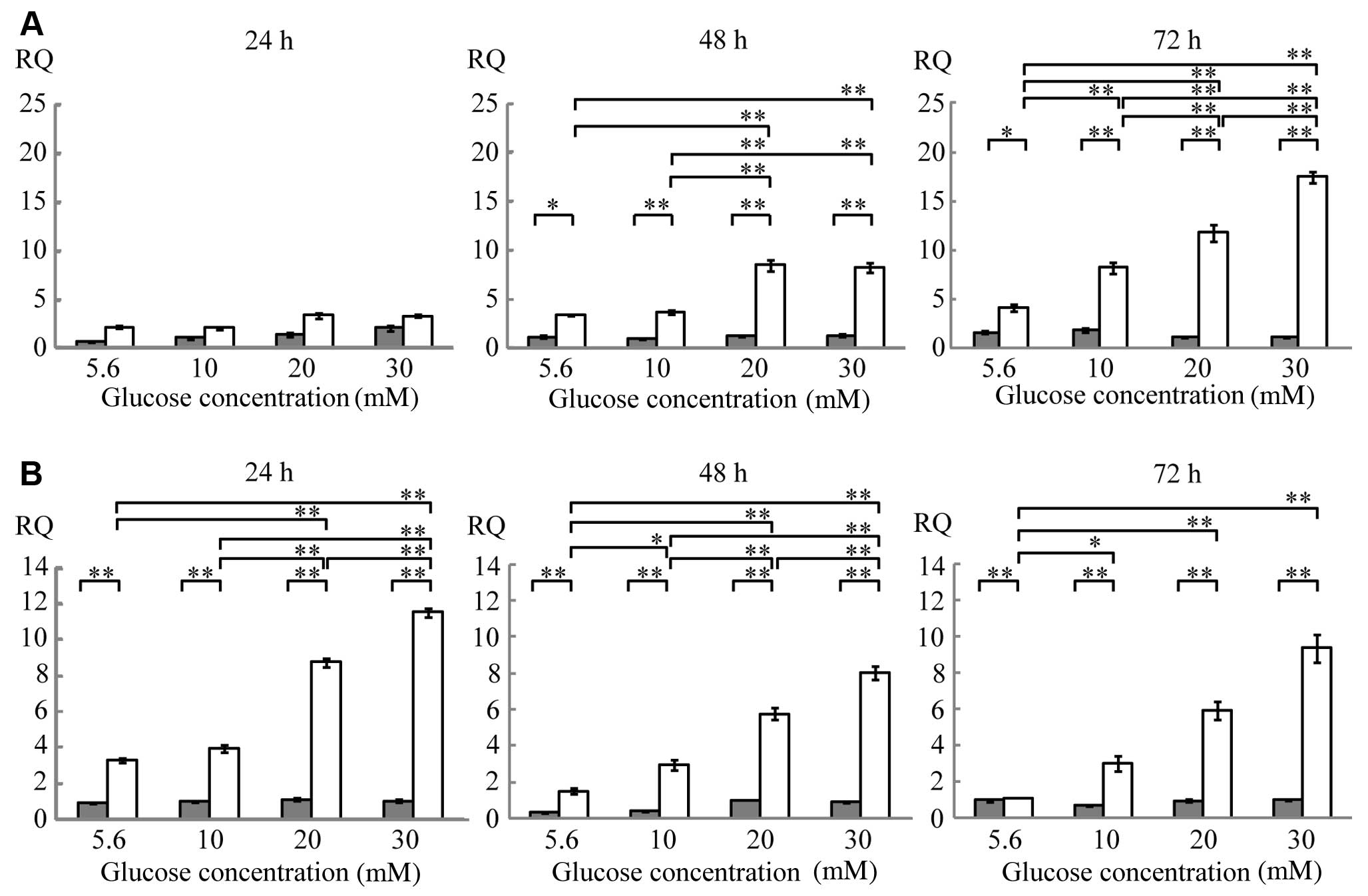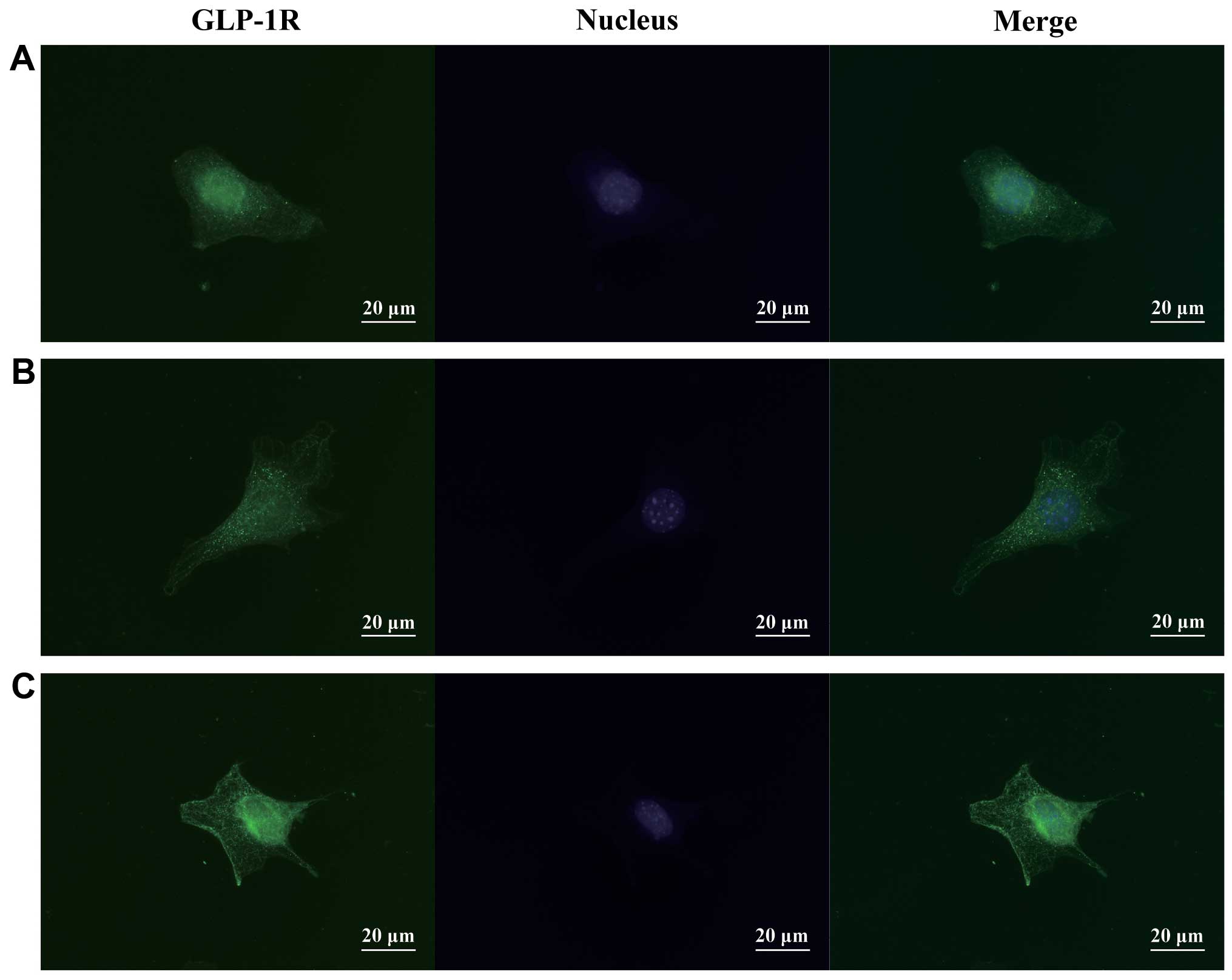|
1
|
Perry T and Greig NH: Enhancing central
nervous system endogenous GLP-1 receptor pathways for intervention
in Alzheimer’s disease. Curr Alzheimer Res. 2:377–385.
2005.PubMed/NCBI
|
|
2
|
Lavin JH, Wittert GA, Andrews J, et al:
Interaction of insulin, glucagon-like peptide 1, gastric inhibitory
polypeptide, and appetite in response to intraduodenal
carbohydrate. Am J Clin Nutr. 68:591–598. 1998.PubMed/NCBI
|
|
3
|
Nikolaidis LA, Elahi D, Hentosz T, et al:
Recombinant glucagon-like peptide-1 increases myocardial glucose
uptake and improves left ventricular performance in conscious dogs
with pacing-induced dilated cardiomyopathy. Circulation.
110:955–961. 2004. View Article : Google Scholar
|
|
4
|
Dupre J, Behme MT, Hramiak IM, et al:
Glucagon-like peptide I reduces postprandial glycemic excursions in
IDDM. Diabetes. 44:626–630. 1995. View Article : Google Scholar : PubMed/NCBI
|
|
5
|
Ding KH, Zhong Q, Xie D, et al: Effects of
glucose-dependent insulinotropic peptide on behavior. Peptides.
27:2750–2755. 2006. View Article : Google Scholar : PubMed/NCBI
|
|
6
|
Miyawaki K, Yamada Y, Ban N, et al:
Inhibition of gastric inhibitory polypeptide signaling prevents
obesity. Nat Med. 8:738–742. 2002. View
Article : Google Scholar : PubMed/NCBI
|
|
7
|
Gaudin-Audrain C, Irwin N, Mansur S, et
al: Glucose-dependent insulinotropic polypeptide receptor
deficiency leads to modifications of trabecular bone volume and
quality in mice. Bone. 53:221–230. 2013.PubMed/NCBI
|
|
8
|
Ceccarelli E, Guarino EG, Merlotti D, et
al: Beyond glycemic control in diabetes mellitus: effects of
incretin-based therapies on bone metabolism. Front Endocrinol
(Lausanne). 4:732013.PubMed/NCBI
|
|
9
|
Hansotia T and Drucker DJ: GIP and GLP-1
as incretin hormones: lessons from single and double incretin
receptor knockout mice. Regul Pept. 128:125–134. 2005. View Article : Google Scholar : PubMed/NCBI
|
|
10
|
Yip RG, Boylan MO, Kieffer TJ and Wolfe
MM: Functional GIP receptors are present on adipocytes.
Endocrinology. 139:4004–4007. 1998. View Article : Google Scholar : PubMed/NCBI
|
|
11
|
Seino Y, Fukushima M and Yabe D: GIP and
GLP-1, the two incretin hormones: similarities and differences. J
Diabetes Invest. 1:8–23. 2010. View Article : Google Scholar : PubMed/NCBI
|
|
12
|
Ferron M, Wei J, Yoshizawa T, et al:
Insulin signaling in osteoblasts integrates bone remodeling and
energy metabolism. Cell. 142:296–308. 2010. View Article : Google Scholar : PubMed/NCBI
|
|
13
|
Kamada A, Ikeo T, Yoshikawa Y, et al: Gene
expression of adipocytokine receptors during osteoblastic
differentiation. J Oral Tissue Eng. 7:53–60. 2009.
|
|
14
|
Huang CY, Lee CY, Chen MY, Tsai HC, Hsu HC
and Tang CH: Adiponectin increases BMP-2 expression in osteoblasts
via AdipoR receptor signaling pathway. J Cell Physiol. 224:475–483.
2010. View Article : Google Scholar : PubMed/NCBI
|
|
15
|
Prigeon RL, Quddusi S, Paty B and
D’Alessio DA: Suppression of glucose production by GLP-1
independent of islet hormones: a novel extrapancreatic effect. Am J
Physiol Endocrinol Metab. 285:E701–E707. 2003.PubMed/NCBI
|
|
16
|
Sancho V, Nuche B, Arnés L, et al: The
action of GLP-1 and exendins upon glucose transport in normal human
adipocytes, and on kinase activity as compared to morbidly obese
patients. Int J Mol Med. 19:961–966. 2007.PubMed/NCBI
|
|
17
|
Vella A, Shah P, Reed AS, Adkins AS, Basu
R and Rizza RA: Lack of effect of exendin-4 and glucagon-like
peptide-1-(7,36)-amide on insulin action in non-diabetic humans.
Diabetologia. 45:1410–1415. 2002.PubMed/NCBI
|
|
18
|
Egan JM, Meneilly GS, Habener JF and Elahi
D: Glucagon-like peptide-1 augments insulin-mediated glucose uptake
in the obese state. J Clin Endocrinol Metab. 87:3768–3773. 2002.
View Article : Google Scholar : PubMed/NCBI
|
|
19
|
Nuche-Berenguer B, Moreno P, Esbrit P, et
al: Effect of GLP-1 treatment on bone turnover in normal, type 2
diabetic, and insulin-resistant states. Calcif Tissue Int.
84:453–461. 2009. View Article : Google Scholar : PubMed/NCBI
|
|
20
|
Yamada C, Yamada Y, Tsukiyama K, et al:
The murine glucagon-like peptide-1 receptor is essential for
control of bone resorption. Endocrinology. 149:574–579. 2008.
View Article : Google Scholar : PubMed/NCBI
|
|
21
|
Bollag RJ, Zhong Q, Phillips P, et al:
Osteoblast-derived cells express functional glucose-dependent
insulinotropic peptide receptors. Endocrinology. 141:1228–1235.
2000.PubMed/NCBI
|
|
22
|
Zhong Q, Itokawa T, Sridhar S, et al:
Effects of glucose-dependent insulinotropic peptide on osteoclast
function. Am J Physiol Endocrinol Metab. 292:E543–E548. 2007.
View Article : Google Scholar : PubMed/NCBI
|
|
23
|
Xie D, Cheng H, Hamrick M, et al:
Glucose-dependent insulinotropic polypeptide receptor knockout mice
have altered bone turnover. Bone. 37:759–769. 2005. View Article : Google Scholar : PubMed/NCBI
|
|
24
|
Mieczkowska A, Irwin N, Flatt PR, Chappard
D and Mabilleau G: Glucose-dependent insulinotropic polypeptide
(GIP) receptor deletion leads to reduced bone strength and quality.
Bone. 56:337–342. 2013. View Article : Google Scholar : PubMed/NCBI
|
|
25
|
Noguchi H, Oishi K, Ueda M, et al:
Establishment of mouse pancreatic stem cell line. Cell Transplant.
18:563–571. 2009.PubMed/NCBI
|
|
26
|
Laemmli UK: Cleavage of structural
proteins during the assembly of the head of bacteriophage T4.
Nature. 227:680–685. 1970. View
Article : Google Scholar : PubMed/NCBI
|
|
27
|
Nuche-Berenguer B, Portal-Núñez S, Moreno
P, et al: Presence of a functional receptor for GLP-1 in
osteoblastic cells, independent of the cAMP-linked GLP-1 receptor.
J Cell Physiol. 225:585–592. 2010. View Article : Google Scholar : PubMed/NCBI
|
|
28
|
Lamari Y, Boissard C, Moukhtar MS,
Jullienne A, Rosselin G and Garel JM: Expression of glucagon-like
peptide 1 receptor in a murine C cell line: regulation of
calcitonin gene by glucagon-like peptide 1. FEBS Lett. 393:248–252.
1996. View Article : Google Scholar : PubMed/NCBI
|
|
29
|
Tsukiyama K, Yamada Y, Yamada C, et al:
Gastric inhibitory polypeptide as an endogenous factor promoting
new bone formation after food ingestion. Mol Endocrinol.
20:1644–1651. 2006. View Article : Google Scholar : PubMed/NCBI
|
|
30
|
Ambrosio ML, Monami M, Sati L, Marchionni
N, Di Bari M and Mannucci E: GLP-1 receptor agonist-induced
polyarthritis: a case report. Acta Diabetol. Oct 25–2013.(Epub
ahead of print).
|
|
31
|
Russell JW, Sullivan KA, Windebank AJ,
Herrmann DN and Feldman EL: Neurons undergo apoptosis in animal and
cell culture models of diabetes. Neurobiol Dis. 6:347–363. 1999.
View Article : Google Scholar : PubMed/NCBI
|
|
32
|
Romeo G, Liu WH, Asnaghi V, Kern TS and
Lorenzi M: Activation of nuclear factor-kappaB induced by diabetes
and high glucose regulates a proapoptotic program in retinal
pericytes. Diabetes. 51:2241–2248. 2002. View Article : Google Scholar : PubMed/NCBI
|
|
33
|
Piconi L, Quagliaro L, Assaloni R, et al:
Constant and intermittent high glucose enhances endothelial cell
apoptosis through mitochondrial superoxide overproduction. Diabetes
Metab Res Rev. 22:198–203. 2006. View
Article : Google Scholar : PubMed/NCBI
|
|
34
|
Weil BR, Abarbanell AM, Herrmann JL, Wang
Y and Meldrum DR: High glucose concentration in cell culture medium
does not acutely affect human mesenchymal stem cell growth factor
production or proliferation. Am J Physiol Regul Integr Comp
Physiol. 296:R1735–R1743. 2009. View Article : Google Scholar : PubMed/NCBI
|
|
35
|
Balint E, Szabo P, Marshall CF and Sprague
SM: Glucose-induced inhibition of in vitro bone mineralization.
Bone. 28:21–28. 2001. View Article : Google Scholar : PubMed/NCBI
|
|
36
|
Yabe D and Seino Y: Two incretin hormones
GLP-1 and GIP: comparison of their actions in insulin secretion and
β cell preservation. Prog Biophys Mol Biol. 107:248–256. 2011.
|
|
37
|
Pedersen J, Ugleholdt RK, Jørgensen SM, et
al: Glucose metabolism is altered after loss of L cells and
alpha-cells but not influenced by loss of K cells. Am J Physiol
Endocrinol Metab. 304:E60–E73. 2013. View Article : Google Scholar : PubMed/NCBI
|
|
38
|
Choi KY, Kim HJ, Lee MH, et al: Runx2
regulates FGF2-induced Bmp2 expression during cranial bone
development. Dev Dyn. 233:115–121. 2005. View Article : Google Scholar : PubMed/NCBI
|
|
39
|
Gigoux V and Fourmy D: Acting on hormone
receptors with minimal side effect on cell proliferation: A timely
challenge illustrated with GLP-1R and GPER. Front Endocrinol
(Lausanne). 4:502013.PubMed/NCBI
|
|
40
|
Monami M, Cresci B, Colombini A, et al:
Bone fractures and hypoglycemic treatment in type 2 diabetic
patients: a case-control study. Diabetes Care. 31:199–203. 2008.
View Article : Google Scholar : PubMed/NCBI
|
|
41
|
Meier C, Kraenzlin ME, Bodmer M, Jick SS,
Jick H and Meier CR: Use of thiazolidinediones and fracture risk.
Arch Intern Med. 168:820–825. 2008. View Article : Google Scholar : PubMed/NCBI
|
|
42
|
Bazelier MT, Gallagher AM, van Staa TP, et
al: Use of thiazolidinediones and risk of osteoporotic fracture:
disease or drugs? Pharmacoepidemiol Drug Saf. 21:507–514. 2012.
View Article : Google Scholar : PubMed/NCBI
|
|
43
|
Monami M, Dicembrini I, Antenore A and
Mannucci E: Dipeptidyl peptidase-4 inhibitors and bone fractures: a
meta-analysis of randomized clinical trials. Diabetes Care.
34:2474–2476. 2011. View Article : Google Scholar
|
|
44
|
Drucker DJ and Nauck MA: The incretin
system: glucagon-like peptide-1 receptor agonists and dipeptidase-4
inhibitors in type 2 diabetes. Lancet. 368:1696–1705. 2006.
View Article : Google Scholar : PubMed/NCBI
|
|
45
|
Tahara N, Yamagishi S, Takeuchi M, et al:
Serum levels of advanced glycation end products (AGEs) are
independently correlated with circulating levels of dipeptidyl
peptidase-4 (DPP-4) in humans. Clin Biochem. 46:300–303. 2013.
View Article : Google Scholar : PubMed/NCBI
|
|
46
|
Yamagishi S and Matsui T: Pleiotropic
effects of glucagon-like peptide-1 (GLP-1)-based therapies on
vascular complications in diabetes. Curr Pharm Des. 17:4379–4385.
2011. View Article : Google Scholar : PubMed/NCBI
|















